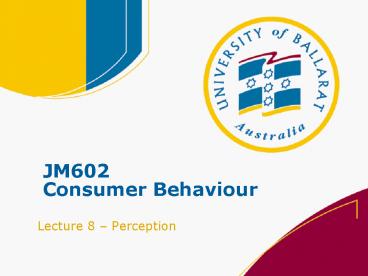JM602 Consumer Behaviour - PowerPoint PPT Presentation
1 / 32
Title:
JM602 Consumer Behaviour
Description:
Neal, Quester and Hawkins (2005). Consumer behaviour: ... Brightly coloured better than dull. 4 colour better than 2. Impact of contrast is important ... – PowerPoint PPT presentation
Number of Views:135
Avg rating:3.0/5.0
Title: JM602 Consumer Behaviour
1
JM602Consumer Behaviour
- Lecture 8 Perception
2
(No Transcript)
3
Material in these slides
- Primarily drawn from
- Neal, Quester and Hawkins (2005). Consumer
behaviour Implications for marketing strategy
(4th ed). McGraw-Hill Irwin Queensland
4
A model of consumer behaviour
5
Perception
- How do consumers process information?
- What are the different steps involved in
information processing? - What factors that influence this process?
- What are the implications of perception for
retail, brand and communication strategies?
85
6
Perception
- Those activities by which an individual acquires
and assigns meaning to stimuli - Is also referred to as information processing
7
What are the different steps involve in
perception?
- Exposure
- Attention
- Interpretation
- Memory
- short-term
- long-term
87
8
Information processing for consumer decision
making
Perception
Exposure
Deliberate
Random
Attention
Low- involvement
High- involvement
Interpretation
High- involvement
Low- involvement
Memory
Short-term
Long-term
Stored experiences, values, decisions, rules etc.
Active problem solving
Purchase consumption decisions
9
Exposure
- Occurs when a stimulus comes within range of our
sensory receptor nerves - Deliberate exposure to stimuli
- consumers seek information that will help achieve
certain goals - immediate
- long-range
- Random exposure to stimuli
89
10
Attention
- Occurs when stimulus activates one or more
sensory receptor nerves and the resulting
sensations go to the brain for processing - Selective process
810
11
Attention Paid to Prime-Time TV Ads
811
12
Attention
- Determined by
- stimulus
- individual
- situation
13
What stimulus factors influence this process?
- Size and intensity
- larger stimuli are more likely to be noticed
- Larger copy is more likely to be noticed
- insertion frequency is important
813
14
The Impact of Advertisement Size
814
15
Stimulus factors
- Colour and movement
- Brightly coloured better than dull
- 4 colour better than 2
- Impact of contrast is important
16
Stimulus factors
- Position
- Placement in persons visual field
- Placed in centre more likely to be noticed
(eye-level space) - First to air television commercial fares better
than last to air - Isolation
- Separation of stimulus object from other objects
17
Stimulus Factors (cont.)
- Format
- Simpler, the better
- Elements that increase effort to process message
tend to decrease attention - Lack a clear visual reference point can be
problematic - However, is individual
18
Stimulus factors
- Contrast
- Attend more closely to stimuli that contrast with
background - Attend more closely to advertisements that are
different to what we expect - Adaptation level theory (volume)
- Compressed messages
- Information quantityinformation overload
19
Attention (cont.)
- Individual factors
- Interest
- Need
- Situational factors
- Involvement
819
20
Involvement and Magazine Advertising Effectiveness
820
21
Involvement in a Television Program and
Advertising Effectiveness
821
22
Non-focused attention
- Subliminal stimuli
23
Determinants of Interpretation
823
24
Interpretation
- Cognitive interpretation
- process of adding meaning
- from existing knowledge
- semantic meaning
- psychological meaning
- Affective interpretation
- processing and adding meaning by feeling
824
25
Encouraging Cognitive Interpretation
825
26
Interpretation (cont.)
- Individual characteristics
- Learning (learned meanings)
- expectations
- Situational characteristics
- e.g. hunger,moods, temperature etc.
- proximity
- Stimulus characteristics
- Sets the basic structure to which an individual
responds
826
27
Perception and Marketing Strategy
- Retail strategy
- Brand name and logo development
- Media strategy
- Advertisement and package design
- Warning labels and package designs
- Advertising evaluation
- Regulation of advertising and packaging
827
28
Retail Strategy
- Store layout to increase exposure
- Lighting and fitout
- Placement of products on shelves
- Eye levels (for adults and for children!)
- Number of facings to maximise visual impact
- Use of referent pricing
828
29
Brand name logo development
- Affects the way the product/service is perceived
- Concrete terms with relevant, established visual
images tend to be easier to recognise and recall - Consistency seems to be important
30
Media Strategy
- Selective approach
- to reach where the target market is
- focused media
- Advertisements package design
- Must capture attention convey meaning
- utilise stimulus characteristics
- Tie message to topic target market is interested
in
830
31
Perception and Marketing Strategy (cont.)
- Advertising evaluation measures of
- Exposure
- It must reach the consumer
- Attention
- It must be attended to by the consumer
- Interpretation
- It must be interpreted correctly
- Memory
- It must be stored and retrievable
831
32
Next Lecture
- Learning and Memory
832































